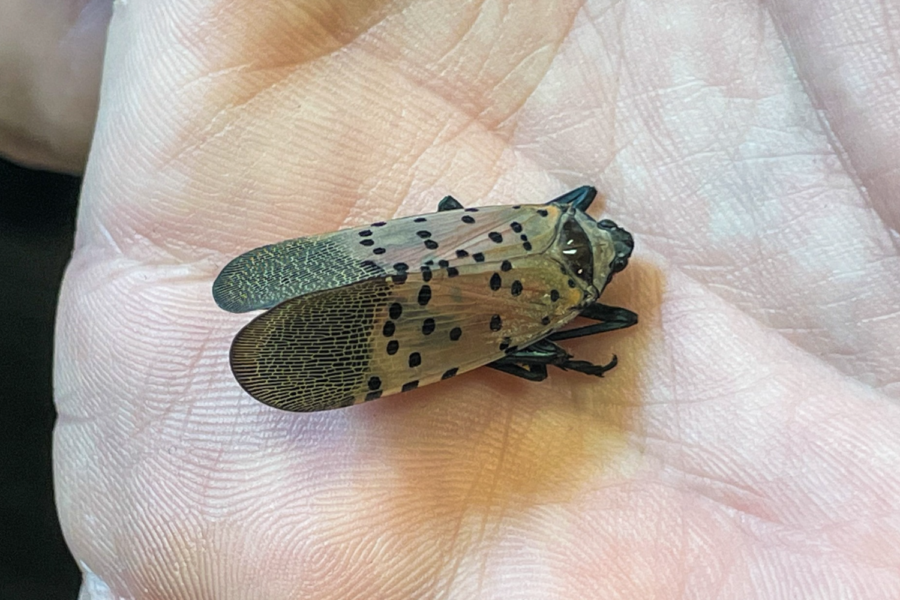Invasive spotted lanternflies have been spotted in Berea. Now what?
While the ecological nuisance spotted lanternfly cannot survive Ohio’s harsh winters, it leaves eggs that can.
Michelle Khoury, The Exponent
Associate zoology professor Andrew Merwin holds a post-mortem spotted lanternfly. The ing-long insect is defined by its red underwings and distinct spots on its forewings.
The spotted lanternfly, known for its large population and threat to the U.S. fruit and wine industry, was spotted in Berea.
Despite the previous sighting, the spotted lanternfly cannot withstand the cold, so the lanternflies now have a lower population. However, they lay their eggs in the fall, which grow through the winter and hatch in spring, creating concerns about future problems.
Multiple government agencies, including the Department of Agriculture, have issued notices to kill the insect on sight to reduce damage to various fruit trees and vines, a favorite snack of the spotted lanternfly. The insect’s eating could endanger not only the produce but also the economy.
The lanternfly lives on plants for their phloem, a sugary juice that helps plants carry out photosynthesis. Lanternflies could potentially deplete the plants of their phloem, which would hinder plant growth and kill the plants and trees.
Andrew Merwin, an entomologist and assistant professor of zoology, said that this only happens in extreme situations.
Spotted lanternflies are not poisonous and do not pose a direct threat to humans and animals.
Lanternflies prefer to live on tree species like the tree of heaven – a species that is highly invasive itself – apple trees, grape vines and maple trees but there are many other trees in which they can still make their home.
Last summer, lanternflies were spotted on a tree of heaven at Coe Lake Park, located less than half a mile from BW’s campus. They have also been spotted in Berea’s Triangle, where there are trees of heaven. Still, there are no trees of heaven on campus, according to Kathryn Flinn, associate professor of biology.
However, the campus has other trees the lanternflies can populate, specifically maple trees.
“If we don’t have them [spotted lanternflies] here already, they’ll be here,” Merwin said.
The lanternflies have multiplied and spread so quickly in other habitats nationwide that some states are hosting “squashathons” where they gather groups of people to forests to kill lanternflies.
“Their populations are going to grow exponentially, and the number of people who go out there and squash these things is always going to stay relatively static, in fact it might decrease as enthusiasm weans,” Merwin said.
Even if enthusiasm for squashathons maintains, Merwin said that with their eggs growing throughout the winter, there will still be enough alive to reproduce.
Throughout the winter, the egg masses are difficult to find because they camouflage with tree bark, so killing the adults is much more appealing than searching for their eggs in the winter, Merwin said.
BW senior Jonah Mitchell told The Exponent that he would not kill the lanternfly unless it posed an immediate danger because he generally prefers not to kill insects, feeling that the less harm he can do, the better.
Merwin said that while the spotted lanternflies are technically harmless, they are still a problem, especially in orchards and vineyards. However, they are not as threatening to the country’s overall landscape as other invasive insects like the emerald ash borer, which have severely damaged and killed countless ash trees.
The solution to the spotted lanternfly issue may lie in time, as natural forces could decrease their population.
Spotted lanternflies reproduce quickly in towns and cities because they aren’t facing the same ecological threats as they do in their native habitats. However, predation and disease might catch up to the lanternfly as native species like insects and birds begin to see the lanternflies as food, Merwin said.
The Exponent is looking for financial contributions to support our staff and our newsroom in producing high-quality, well-reported and accurate journalism. Thank you for taking the time to consider supporting our student journalists.













































